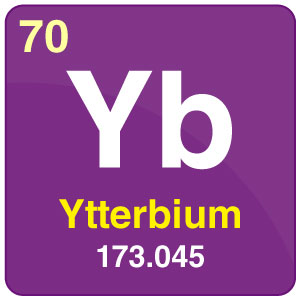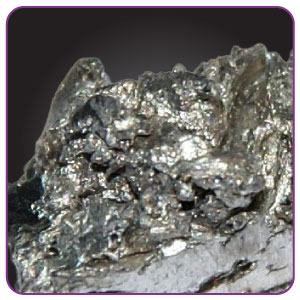Ytterbium

| Symbol | Yb |
| Atomic Number | 70 |
| Atomic Mass | 173.045 |
| Discovered by | Ytterbium was discovered by Jean Charles Galissard de Marignac |

Chemical Properties of Ytterbium
| Group | Lanthanides | Melting point | 824°C, 1515°F, 1097 K |
| Period | 6 | Boiling point | 1196°C, 2185°F, 1469 K |
| Block | f | Density (g cm−3) | 6.90 |
| Atomic number | 70 | Relative atomic mass | 173.045 |
| State at 20°C | Solid | Key isotopes | 172Yb, 173Yb, 174Yb |
| Electron configuration | [Xe] 4f14 6s2 | CAS number | 7440-64-4 |
| ChemSpider ID | 22428 | ChemSpider is a free chemical database | |
What is Ytterbium?
- Ytterbium is an element of the periodic table with an atomic number of 70, discovered by Jean de Marignac in the year 1878. The element is named after Ytterby, the village in Sweden.
- It is a white silvery, soft, ductile and rare earth metal.
- It is attacked by strong acids and reacts slowly with cold water and air. It is oxidised by air to the corresponding oxide which forms the protective layer on the surface of Ytterbium. It tarnishes slowly in the air to golden or brown colour.
- Natural Ytterbium is a mixture of seven isotopes namely 168Yb, 170Yb, 171Yb, 172Yb, 173Yb, 174Yb, and 176Yb.
- It is found in three major minerals monazite, euxenite, and xenotime.
- The physical properties of Ytterbium differ widely when compared to other elements.
- Usually, elements will have ferromagnetic and antiferromagnetic properties at low temperatures but it is paramagnetic at a temperature above 1.0 Kelvin. The alpha allotrope of Ytterbium is diamagnetic.
- Ytterbium can form dihalides and trihalides but most of the compounds of Ytterbium are in +3 state. Dihalides undergo disproportionation to give trihalides and metallic ytterbium.
Uses of Ytterbium
- Ytterbium clocks are the world’s most stable atomic clock. Numerous atoms present in the element make the clock more stable
- (to within less than two parts in 1 quintillion).
- It is used as a doping agent to improve the strength, grain refinement and mechanical properties of stainless steel.
- It also acts as an industrial catalyst.
- Few alloys of Ytterbium are used in dentistry.
- Ytterbium is a silvery-white metal that is electropositive and reacts with water to form ytterbium hydroxide.
- Nowadays, this is element is used in the making of memory devices and tunable lasers.


Comments